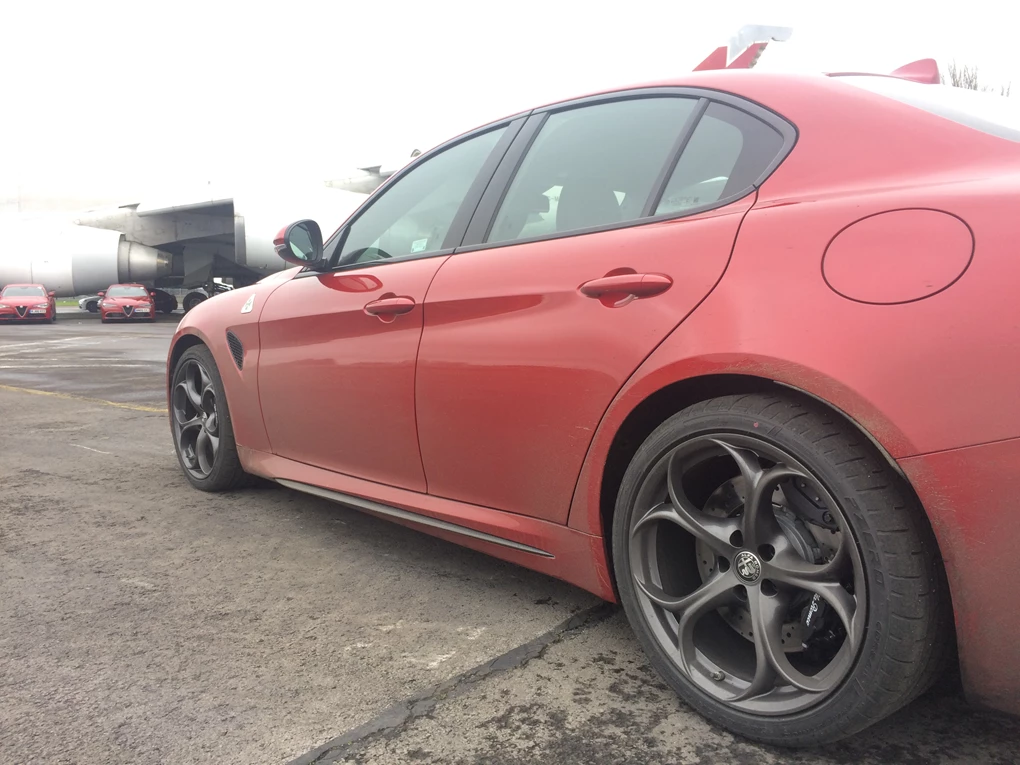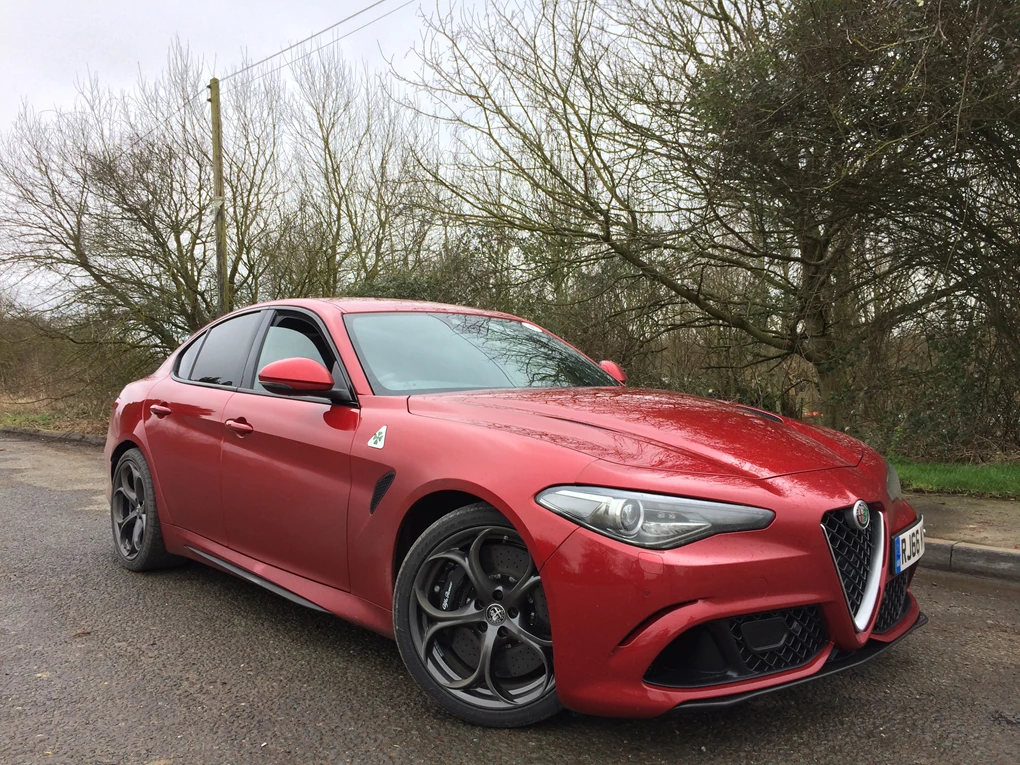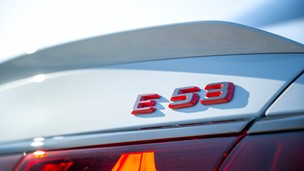Alfa Romeo fans, this is the car you’ve been waiting for. And you have no idea how fantastic it feels to have just written that sentence.
We probably don’t have to tell you what this is, but we will anyway. In essence, it’s the first proper drivers’ Alfa in nearly forty years, a rear-wheel drive return to form that’s high on horsepower and light on weight.
Engineered with more than just a bit of Ferrari trickery, the 503bhp Quadrifoglio is the fastest and most hardcore version of the new Giulia saloon, a direct rival for the likes of BMW’s M cars and Mercedes’ AMG range, and the car fashioned to restore Alfa Romeo’s flagging fortunes.
We don’t have to tell you about the QV’s pornographically gorgeous looks either, but, again, we will anyway. It looks much more aggressive and far more purposeful than virtually any rival, with those sleek lines juxtaposed by twin heat extractors on the bonnet, vicious side sills and an active carbon splitter at the front – all of which are designed as much for performance as for beauty.
Remember too, this isn’t just the car touted to reinstate Alfa’s reputation, it lapped the Nürburgring a full 13 seconds quicker than the BMW M4, beating cars like the Audi R8 and Lamborghini Gallardo Superleggera along the way. The only question we have is: what took so long?
Performance
If you’re anything like us, you’ve been watching the Quadrifoglio’s development with baited breath, scouring every update and teaser video for more information. So, it’s easy to assume you’ll be familiar with the specs, but just in case you’re not, here’s a quick rundown:
While the regular Giulia range is powered by a variety of petrol and diesel engines, the QV comes powered by a 2.9-litre twin-turbocharged petrol V6 engine. Alfa says that it’s “Ferrari inspired”, though most people will be aware that the connection goes a bit deeper than that.
Nobody will ever admit to it, but it’s basically the same V8 that comes in the Ferrari California but with two cylinders lopped off the end. You didn’t hear that from us, though. In any case, it produces 503bhp with a whopping 600Nm of torque, which is transferred directly to the rear wheels via an eight-speed ZF automatic gearbox and a carbon fibre driveshaft.
It’s quick enough to hit 62mph from a standing start in just 3.9 seconds, and it’ll top out at an eyeball-popping 191mph, making it the fastest-accelerating car in its class, and the one with the highest top speed. But the numbers are barely half of the story, because the way this car builds speed is nothing short of absurd.
You might think that with all that power the Quadrifoglio would be a dead ringer for an all-torque-no-traction AMG, but it accelerates so, so smoothly it’s scarcely believable. Part of that is down to the car’s ECU brain, which limits initial torque delivery in all modes exception its most extreme ‘Race’ setting. It means you can plant the throttle and, instead of ungracefully fishtailing into the nearest hedgerow, you simply glide off towards the horizon at an incredible lick.
.jpg)
Like a magnesium/aluminium fist inside a glove of the most supremely crafted Italian velvet, we’ve rarely known a car to deliver so much power and raw ferocity so smoothly, to the point you hardly notice what you’re doing until you happen to glance down at the speedo and notice that you’re comfortably in excess of triple figures.
It sounds great, too. Perhaps not as full-bodied as some other V6s, but then that’s what you get for slapping two big turbos in front of it. Certainly, it sounds a lot better than the pumped-in fakery of some rivals and, particularly in ‘Race’ mode, the car really cranks up the drama with bangs and snorts from the tailpipes on upshifts and a pleasingly rorty burble on idle.
Is the fact that we don’t get a manual here in the UK sad? Yeah, a bit, but the eight-speed ZF in this car is fantastic. Unlike some other manufacturers, which just bolt in the gearbox straight off the shelf, Alfa did what BMW does and spent considerable time tweaking it to be just right for the car.
In all our time, we’re struggling to remember a ZF to shift so aggressively, with lightning sharp changes and none of the dithering that plagues lesser auto transmissions. The metal gear shifters are a particular highlight too: large enough to swap cogs mid-corner and lending a real tactile, mechanical feel to the proceedings.
Honestly, within the space of 20 minutes spent blat-blatting the QV around your favourite road or track, you’ll forget all about the manual.
Ride and Handling
Make no mistake about it, this is the best driving Alfa Romeo in years and a true return to form for one of the most revered car manufacturers of all
The Giulia Quadrifoglio’s Ferrari connection doesn’t just end with the engine, either. Both the motor and the car’s chassis were developed by ex-Ferrari engineers, and it shows. Make no mistake about it, this is the best driving Alfa Romeo in years and a true return to form for one of the most revered car manufacturers of all. Alfa put an extreme focus on both lightweighting and aerodynamics to improve the capabilities of the QV, with a chassis manufactured from aluminium, while the car makes extensive use of magnesium composites and carbon fibre to reduce its kerb weight. The Giulia is the only car in its class to come with a carbon fibre bonnet, while the Quadrifoglio version also gains a carbon roof, an active aerodynamic splitter at the front and a huge diffuser at the rear – also carbon, of course. Weighing in at just 1,524kg and with a 0.25 drag coefficient that’s more slippery than the slickest bar of prison-shower soap, it cuts through air and tarmac alike like a hot knife through smoke. It’s a beautifully balanced car to drive and handles brilliantly on all surfaces, while aluminium double wishbone suspension at the front and multi-link suspension at the rear lends real responsiveness that’s surefooted, incredibly planted and yet nowhere near as stiff as you might expect from a car of this type. You still won’t want to tackle potholes head on, of course, but the Quadrifoglio has such a smooth pliancy to its ride that you’ll probably never even have to bother hitting the comfort mode button, even with the massive 19-inch alloys and on the sorts of cracked-up country roads we tested the car on. There’s a real sense of control to how it drives too; it doesn’t squirm around at the back over crests and on soggy tarmac like one of the M3/M4 siblings would, it’s much more finessed than an AMG and more exciting than an RS 5. The steering is razor sharp and incredibly quick too, meaning that you can practically pitch the car into corners telepathically. It’s jolly good fun and extremely chuckable, the steering lending scalpel-like precision that allows you to bang it into bends on a moments' notice, though in 'Natural' mode it can feel a little light in the hands. Selecting Dynamic weights things up a bit more and lets you hang onto gears longer in automatic mode, while it also allows for a surprising amount of rear-end slip in the corners before it’ll reign you back in. It’s tonnes of fun but feels incredibly natural, cutting in to limit the amount of oversteer just at exactly the point you’d naturally countersteer to catch and correct it. If proper sideways skiddy things are your bag, it can do that too when you select ‘Race’ mode on the rotary DNA dial. Stability control isn’t quite completely switched off in ‘Race’ but it’s still strictly for track-only use. But, if you’ve got the space and a set of spares, the rapid steering and specially-developed Pirelli tyres make it incredibly easy to coax it progressively into more and more extreme slip angles. If you’re partial to that sort of thing. We’re not entirely convinced by the car’s brake-by-wire system – which means the brakes are engaged by small electric actuators rather than a conventional hydraulic system – which can make the brake pedal feel a bit spongy and like there’s a little too much travel. That said, there’s no doubting the ability of the huge rotors to slow you down, particularly if you spec carbon ceramic discs – a £5,500 option, by the way.

Interior and Equipment
‘Quadrifoglio’ means ‘four-leaf’ in Italian and refers to the green-on-white cloverleaf badge which was originally fixed to Alfa Romeo’s racing cars as a good luck token.
It’s no secret that modern Alfa interiors have been no great shakes, ranging from the mundane to the ridiculous, and so it’s such a pleasure to be able to say that the Giulia’s interior is as special as the rest of the car. Drop into the low seats and you’re met with plenty of nice soft-touch leather and racy-looking carbon fibre bits, while the white and green stitching exclusive to the Quadrifoglio is a nice touch as well. There’s plenty of room in the cabin, twin cupholders and decent storage space, but the real star attraction is the steering wheel, which gets a slimmed-down, three-spoke design, a big wad of Alcantara up top and a with rather arresting Ferrari-style ignition button mounted on it. As standard, the car comes with heated, electrically adjustable leather sports seats, though for an extra £2,500 you can opt for Sparco carbon-backed bucket seats which make the interior even more dramatic than it already is. They’re a nice extra and both options feature a wide range of adjustability, though unless you plan on tracking the car often we reckon the standard seats are probably the ones to go for. Given that it sits at the very top of the Giulia range, the QV is also packed with standard kit. There’s an 8.8-inch Uconnect infotainment system with sat-nav, a reversing camera, DAB radio and Bluetooth integration. Front and rear parking sensors are also standard, as are bi-Xenon headlights, dual-zone climate control, cruise control and a wide range of safety kit like autonomous emergency braking – enough, in fact, to reward the Giulia range with a five-star Euro NCAP crash safety rating. So far so good, but so what’s the rub? Well, some of the materials are noticeably not as good as the best in the car’s class; the parking brake button feels cheap, while the glovebox handle didn’t quite sit flush on our test car. The infotainment system, which is integrated into the centre console and does indeed look nice, is quite a way off the best in class too. It’s a bit small, a bit slow and the resolution on the reversing camera isn’t great. You might say it wouldn’t be a proper Alfa unless something was a bit off, and we’re glad this is the car’s biggest problem, but it’s still a long way behind rivals. That said, it’s a surprisingly usable car too, with generous amounts of leg and headroom for rear passengers, while the Giulia’s 480-litre boot is bang on par with its direct rivals and is well proportioned for loading in bulky items. Like a set of spare tyres, perhaps…?
Cost
Alfa claims that the QV can return a combined 34.4mpg with CO2 emissions of 189g/km, though if you drive it like you’re supposed to you’ll probably get a lot less
While the regular Giulia starts from £29,180, the Quadrifoglio is predictably much more expensive. The base car is priced from £59,000 on the road, which makes it a bit pricier than the BMW M3, but still less than cars like the Mercedes C 63 AMG or the Audi RS 5. However, once you factor in things like optional extras the price can swell considerably. Our test model, which came with the likes of the carbon-backed seats and carbon ceramic brakes had a list price of £73,505. Running costs will be predictably high as well. Alfa claims that the QV can return a combined 34.4mpg with CO2 emissions of 189g/km, though if you drive it like you’re supposed to you’ll probably get a lot less. One other thing to bear in mind is residual values. The manufacturer claims that the Giulia range will sit around the middle of the table in terms of residuals, due to the fact that it still carries considerable baggage in terms of historical reliability issues, and this could well have an impact on whether or not you buy one.
Our Verdict
If you had to summarise the Alfa Romeo Giulia Quadrifoglio in just one word, it would probably be “finally”. It’s beautiful to look at, beautiful to drive and marks an extremely welcome return to form for what still remains one of the world’s most iconic car manufacturers. It has its faults, namely a sub-par infotainment architecture and the potential to be hobbled by uncertain residual values, but it’s such a spectacular car that it’s hard not to be bowled over by it. This is the best Alfa Romeo for decades, short and simple, and it’s been more than worth the wait. We can’t ignore its shortcomings, but Alfa has always been one of those companies for which heart is as important, if not more important, than head. To our heads it’s still fantastic, but in our hearts it’s a five-star car all day, every day. Welcome back, Alfa Romeo.





